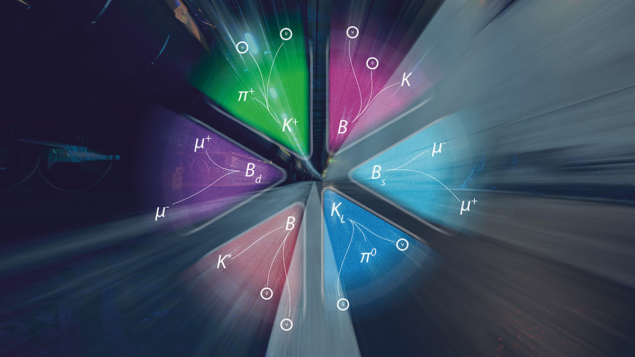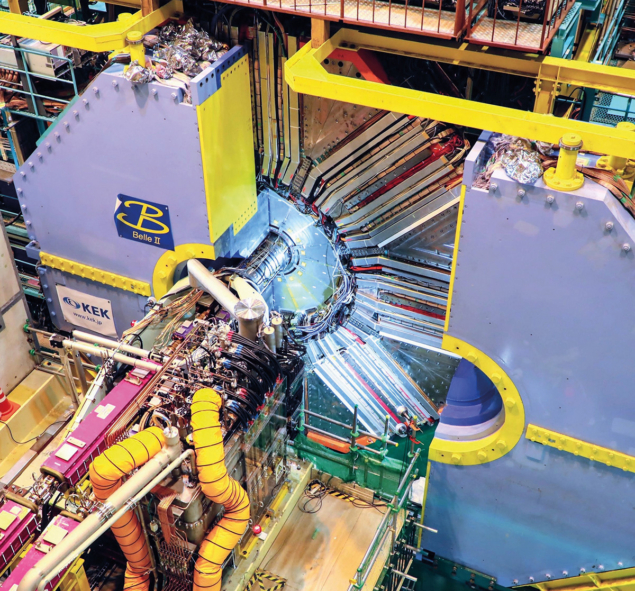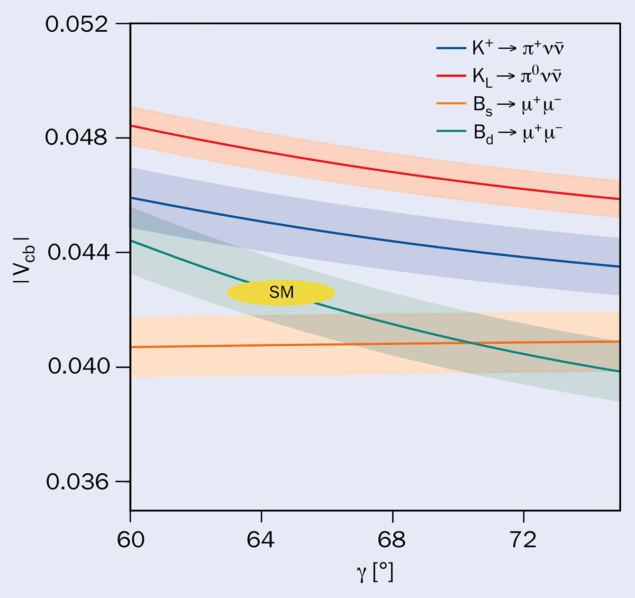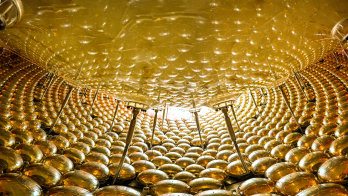Andrzej Buras explains how two rare kaon decays and four rare B-meson decays will soon probe for new physics beyond the reach of direct searches at colliders.

Thanks to its 13.6 TeV collisions, the LHC directly explores distance scales as short as 5 × 10–20 m. But the energy frontier can also be probed indirectly. By studying rare decays, distance scales as small as a zeptometre (10–21 m) can be resolved, probing the existence of new particles with masses as high as 100 TeV. Such particles are out of the reach of any high-energy collider that could be built in this century.
The key concept is the quantum fluctuation. Just because a collision doesn’t have enough energy to bring a new particle into existence does not mean that a very heavy new particle cannot inform us about its existence. Thanks to Heisenberg’s uncertainty principle, new particles could be virtually exchanged between the other particles involved in the collisions, modifying the probabilities for the processes we observe in our detectors. The effect of massive new particles could be unmistakable, giving physicists a powerful tool for exploring more deeply into the unknown than accelerator technology and economic considerations allow direct searches to go.
The effect of massive new particles could be unmistakable
The search for new particles and forces beyond those of the Standard Model is strongly motivated by the need to explain dark matter, the huge range of particle masses from the tiny neutrino to the massive top quark, and the asymmetry between matter and antimatter that is responsible for our very existence. As direct searches at the LHC have not yet provided any clue as to what these new particles and forces might be, indirect searches are growing in importance. Studying very rare processes could allow us to see imprints of new particles and forces acting at much shorter distance scales than it is possible to explore at current and future colliders.
Anticipating the November Revolution
The charm quark is a good example. The story of its direct discovery unfolded 50 years ago, in November 1974, when teams at SLAC and MIT simultaneously discovered a charm–anticharm meson in particle collisions. But four years earlier, Sheldon Glashow, John Iliopoulos and Luciano Maiani had already predicted the existence of the charm quark thanks to the surprising suppression of the neutral kaon’s decay into two muons.
Neutral kaons are made up of a strange quark and a down antiquark, or vice versa. In the Standard Model, their decay to two muons can proceed most simply through the virtual exchange of two W bosons, one virtual up quark and a virtual neutrino. The trouble was that the rate for the neutral kaon decay to two muons predicted in this manner turned out to be many orders of magnitude larger than observed experimentally.

Glashow, Iliopoulos and Maiani (GIM) proposed a simple solution. With visionary insight, they hypothesised a new quark, the charm quark, which would totally cancel the contribution of the up quark to this decay if their masses were equal to each other. As the rate was non-vanishing and the charm quark had not yet been observed experimentally, they concluded that the mass of the charm quark must be significantly larger than that of the up quark.
Their hunch was correct. In early 1974, months before its direct discovery, Mary K Gaillard and Benjamin Lee predicted the charm quark’s mass by analysing another highly suppressed quantity, the mass difference in K0–K0 mixing.
As modifications to the GIM mechanism by new heavy particles are still a hot prospect for discovering new physics in the 2020s, the details merit a closer look. Years earlier, Nicola Cabibbo had correctly guessed that weak interactions act between up quarks and a mixture (d cos θ + s sin θ) of the down and strange quarks. We now know that charm quarks interact with the mixture (–d sin θ + s cos θ). This is just a rotation of the down and strange quarks through this Cabibbo angle. The minus sign causes the destructive interference observed in the GIM mechanism.
With the discovery of a third generation of quarks, quark mixing is now described by the Cabibbo–Kobayashi–Maskawa (CKM) matrix – a unitary three-dimensional rotation with complex phases that parameterise CP violation. Understanding its parameters may prove central to our ability to discover new physics this decade.
On to the 1980s
The story of indirect discoveries continued in the late 1980s, when the magnitude of B0d – B0d mixing implied the existence of a heavy top quark, which was confirmed in 1995, completing the third generation of quarks. The W, Z and Higgs bosons were also predicted well in advance of their discoveries. It’s only natural to expect that indirect searches for new physics will be successful at even shorter distance scales.

Rare weak decays of kaons and B mesons that are strongly suppressed by the GIM mechanism are expected to play a crucial role. Many channels of interest are predicted by the Standard Model to have branching ratios as low as 10–11, often being further suppressed by small elements of the CKM matrix. If the GIM mechanism is violated by new-physics contributions, these branching ratios – the fraction of times a particle decays that way – could be much larger.
Measuring suppressed branching ratios with respectable precision this decade is therefore an exciting prospect. Correlations between different branching ratios can be particularly sensitive to new physics and could provide the first hints of physics beyond the Standard Model. A good example is the search for the violation of lepton-flavour universality (CERN Courier May/June 2019 p33). Though hints of departures from muon–electron universality seem to be receding, hints that muon–tau universality may be violated still remain, and the measured branching ratios for B → K(K*)µ+µ– differ visibly from Standard Model predictions.
The first step in this indirect strategy is to search for discrepancies between theoretical predictions and experimental observables. The main challenge for experimentalists is the low branching ratios for the rare decays in question. However, there are very good prospects for measuring many of these highly suppressed branching ratios in the coming years.
Six channels for the 2020s
Six channels stand out today for their superb potential to observe new physics this decade. If their decay rates defy expectations, the nature of any new physics could be identified by studying the correlations between these six decays and others.
The first two channels are kaon decays: the measurements of K+ → π+νν by the NA62 collaboration at CERN (see “Needle in a haystack” image), and the measurement of KL → π0νν by the KOTO collaboration at J-PARC in Japan. The branching ratios for these decays are predicted to be in the ballpark of 8 × 10–11 and 3 × 10–11, respectively.

The second two are measurements of B → Kνν and B → K*νν by the Belle II collaboration at KEK in Japan. Branching ratios for these decays are expected to be much higher, in the ballpark of 10–5.
The final two channels, which are only accessible at the LHC, are measurements of the dimuon decays Bs → µ+µ– and Bd → µ+µ– by the LHCb, CMS and ATLAS collaborations. Their branching ratios are about 4 × 10–9 and 10–10 in the Standard Model. Though the decays B → K(K*)µ+µ–are also promising, they are less theoretically clean than these six.
The main challenge for theorists is to control quantum-chromodynamics (QCD) effects, both below 10–16 m, where strong interactions weaken, and in the non-perturbative region at distance scales of about 10–15 m, where quarks are confined in hadrons and calculations become particularly tricky. While satisfactory precision has been achieved at short-distance scales over the past three decades, the situation for non-perturbative computations is expected to improve significantly in the coming years, thanks to lattice QCD and analytic approaches such as dual QCD and chiral perturbation theory for kaon decays, and heavy-quark effective field theory for B decays.
Another challenge is that Standard Model predictions for the branching ratios require values for four CKM parameters that are not predicted by the Standard Model, and which must be measured using kaon and B-meson decays. These are the magnitude of the up-strange (Vus) and charm-bottom (Vcb) couplings and the CP-violating phases β and γ. The current precision on measurements of Vus and β is fully satisfactory, and the error on γ = (63.8 ± 3.5)° should be reduced to 1° by LHCb and Belle II in the coming years. The stumbling block is Vcb, where measurements currently disagree. Though experimental problems have not been excluded, the tension is thought to originate in QCD calculations. While measurements of exclusive decays to specific channels yield 39.21(62) × 10–3, inclusive measurements integrated over final states yield 41.96(50) × 10–3. This discrepancy makes the predicted branching ratios differ by 16% for the four B-meson decays, and by 25% and 35% for K+ → π+νν and KL → π0νν. These discrepancies are a disaster for the theorists who had succeeded over many years of work to reduce QCD uncertainties in these decays to the level of a few percent.
One solution is to replace the CKM dependence of the branching ratios with observables where QCD uncertainties are under good control, for example: the mass differences in B0s − B0s and B0d − B0d mixing (∆Ms and ∆Md); a parameter that measures CP violation in K0 – K0 mixing (εK); and the CP-asymmetry that yields the angle β. Fitting these observables to the experimental data avoids us being forced to choose between inclusive and exclusive values for the charm-bottom coupling, and avoids the 3.5° uncertainty on γ, which in this strategy is reduced to 1.6°. Uncertainty on the predicted branching ratios is thereby reduced to 6% and 9% for B → Kνν and B → K*νν, to 5% for the two kaon decays, and to 4% for Bs → µ+µ– and Bd → µ+µ–.
So what is the current experimental situation for the six channels? The latest NA62 measurement of K+ → π+νν is 25% larger than the Standard Model prediction. Its 36% uncertainty signals full compatibility at present, and precludes any conclusions about the size of new physics contributing to this decay. Next year, when the full analysis has been completed, this could turn out to be possible. It is unfortunate that the HIKE proposal was not adopted (CERN Courier May/June 2024 p7), as NA62’s expected precision of 15% could have been reduced to 5%. This could turn out to be crucial for the discovery of new physics in this decay.
The present upper bound on KL → π0νν from KOTO is still two orders of magnitude above the Standard Model prediction. This bound should be lowered by at least one order of magnitude in the coming years. As this decay is fully governed by CP violation, one may expect that new physics will impact it significantly more than CP-conserving decays such as K+ → π+νν.
Branching out from Belle
At present, the most interesting result concerns a 2023 update from Belle II to the measured branching ratio for B+ → K+νν (see “Interesting excess” image). The resulting central value from Belle II and BaBar is currently a factor of 2.6 above the Standard Model prediction. This has sparked many theoretical analyses around the world, but the experimental error of 30% once again does not allow for firm conclusions. Measurements of other charge and spin configurations of this decay are pending.
Finally, both dimuon B-meson decays are at present consistent with Standard Model predictions, but significant improvements in experimental precision could still reveal new physics at work, especially in the case of Bd.

It will take a few years to conclude if new physics contributions are evident in these six branching ratios, but the fact that all are now predicted accurately means that we can expect to observe or exclude new physics in them before the end of the decade. This would be much harder if measurements of the Vcb coupling were involved.
So far, so good. But what if the observables that replaced Vcb and γ are themselves affected by new physics? How can they be trusted to make predictions against which rare decay rates can be tested?
Here comes some surprisingly good news: new physics does not appear to be required to simultaneously fit them using our new basis of observables ΔMd, εK and ΔMs, as they intersect at a single point in the Vcb–γ plane (see “No new physics” figure). This analysis favours the inclusive determination of Vcb and yields a value for γ that is consistent with the experimental world average and a factor of two more accurate. It’s important to stress, though, that non-perturbative four-flavour lattice-QCD calculations of ∆Ms and ∆Md by the HPQCD lattice collaboration played a key role here. It is crucial that another lattice QCD collaboration repeat these calculations, as the three curves cross at different points in three-flavour calculations that exclude charm.
Interesting years are ahead in the field of indirect searches for new physics
In this context, one realises the advantages of Vcb–γ plots compared to the usual unitarity-triangle plots, where Vcb is not seen and 1° improvements in the determination of γ are difficult to appreciate. In the late 2020s, determining Vcb and γ from tree-level decays will be a central issue, and a combination of Vcb-independent and Vcb-dependent approaches will be needed to identify any concrete model of new physics.
We should therefore hope that the tension between inclusive and exclusive determinations of Vcb will soon be conclusively resolved. Forthcoming measurements of our six rare decays may then reveal new physics at the energy frontier (see “New physics” figure). With a 1° precision measurement of γ on the horizon, and many Vcb-independent ratios available, interesting years are ahead in the field of indirect searches for new physics.
In 1676 Antonie van Leeuwenhoek discovered a microuniverse populated by bacteria, which he called animalcula, or little animals. Let us hope that we will, in this decade, discover new animalcula on our flavour expedition to the zeptouniverse.
Further reading
A J Buras and E Venturini 2021 Acta. Phys. Polon. B 53 6–A1 (arXiv:2109.11032).
A J Buras and E Venturini 2022 Eur. Phys. J. C 82 615 (arXiv:2203.11960).
A J Buras 2022 Eur. Phys. J. C 82 612 (arXiv:2204.10337).
A J Buras 2023 Eur. Phys. J. C 83 66 (arXiv:2209.03968).







